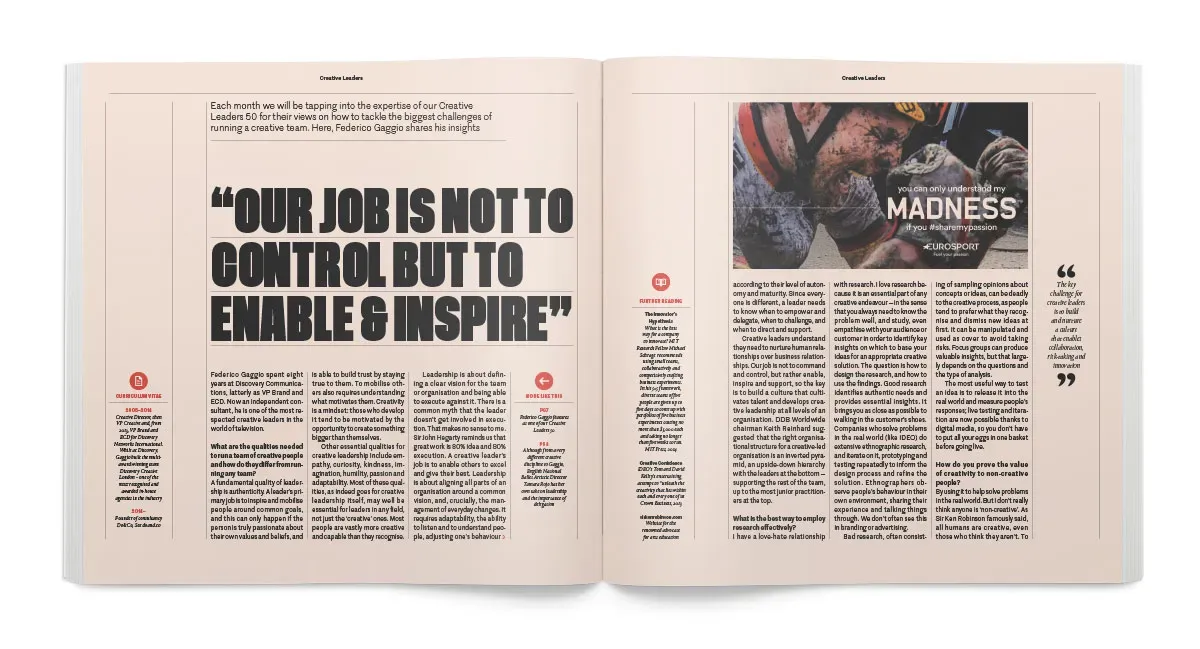Leading from the Culture

Creative Review asked me to contribute views and insights on Creative Leadership in occasion of the launch of the magazine's strand of content aimed at those who lead, and aspire to lead, creative teams, departments and businesses.
A version of this article appeared on the June 2016 issue of Creative Review
What are the qualities needed to run a team of creative people and how do they differ from running any team?
A fundamental quality of leadership is authenticity. A leader’s primary job is to inspire and mobilise people around common goals, and this can only happen if the person is truly passionate about their own values and beliefs, and is able to build trust by staying true to them. To mobilise others also requires understanding what motivates them. Creativity is a mindset: those who develop it tend to be motivated by the opportunity to create something bigger than themselves.
Other essential qualities for creative leadership include empathy, curiosity, kindness, imagination, humility, passion and adaptability. Most of these qualities, as indeed creative leadership itself, may well be essential for leaders in any field, not just the ‘creative’ ones. Most people are vastly more creative and capable than they recognise.
Leadership is about defining a clear vision for the team or organisation and being able to execute against it. There is a common myth that the leader does’t get involved in execution. That makes no sense to me. Sir John Hegarty reminds us that great work is 80% idea and 80% execution. A creative leader’s job is to enable others to excel and give their best. Leadership is about aligning all parts of an organisation around a common vision, and, crucially, the management of everyday changes. It requires adaptability, the ability to listen and understand people, adjusting one’s behaviour according to their level of autonomy and maturity. Since everyone is different, a leader needs to know when to empower and delegate, when to challenge, and when to direct and support.
Prof. Doug Guthrie suggests that leadership is “structure, culture and a state of mind”. The formalised practices of business, especially in hierarchical corporate organisations, often generate distance between people. Creative leaders understand they need to nurture human relationships over business relationships. Our job is not to command and control, but rather enable, inspire and support, so the key is to build a culture that cultivates talent and develops creative leadership at all levels of an organisation. DDB Worldwide chairman Keith Reinhard suggested that the right organisational structure for a creative-led organisation is an inverted pyramid, an upside-down hierarchy with the leaders at the bottom — supporting the rest of the team, up to the most junior practitioners at the top.
Can you explain the role of research in what you do — in pre-concept stages, through pre-launch to post-launch?
I have a love-hate relationship with research. I love research because it is an indispensable part of any creative endeavour — in the sense that you always need to know the problem well, and study, even empathise with your audience or customer in order to identify key insights on which to base your ideas for an appropriate creative solution. The question is how to design the research, and how to use the findings. Good research identifies authentic needs and provides crucial insights. It brings you as close as possible to walking in the customer’s shoes. Companies who solve problems in the real world (like IDEO) do extensive ethnographic research, and iterate on it, prototyping and testing repeatedly to inform the design process and refine the solution. Ethnographers observe people’s behaviour in their own environment, sharing their experience and talking things through. We don’t often see this in branding or advertising.
Bad research, often consisting in sampling opinions about concepts or ideas, can be deadly to the creative process, as people tend to prefer what they recognise and dismiss new ideas at first. It can be manipulated and used as cover to avoid taking risks. Focus groups can produce valuable insights, but that largely depends on the questions and the type of analysis. The simplest way to put this is: when you ask people how they feel about something, they can only tell you what they think they feel, which is not the data you are looking for. That is why I don’t believe in testing ideas with focus groups. The most useful way to test an idea is to release it into the real world and measure people’s responses; live testing and iteration are now possible thanks to digital media, so you don’t have to put all your eggs in one basket before going live. You may run your digital campaign before combining it with expensive TV and outdoor, gathering real insights on how people responds to it before spending the big bucks.
How can you budget for projects that are open-ended, iterative, always mutating? How do you work out who you need and for how long?
In some ways a budget is always an assumption at a point in time. When I worked at Discovery, we started the budget planning process in August for the following year. At that point I had no way to establish what we were going to make and how. I had to start from assumptions: what we made that year; how was it made, and how much did we spend; what worked and what didn’t, what was more important… I did this as thoroughly as possible, preparing well for the finance meetings. Most of the time the meeting consisted in the finance director looking at once at the total figure, asking one or two questions, and saying one of two things: «Keep it flat on last year» (this was a good year). Or: «we need to make savings somewhere else, so you need to cut …» As finance is tasked with protecting margins, their mantra is always “more with less”, being more efficient — while our priority is raising the bar of excellence and effectiveness. It makes you focus on what’s important: the more limited your means, the more you need to prioritise and allocate resources where you need them most. Needless to say, it reduces the scope for failure and iteration: you bet on a few blockbusters, a handful of priorities that take the lion share of your resources, so you can give them enough love. But blockbuster failures tend to have blockbuster consequences. Besides, everything we do affects the viewer or customer experience, so even no-money projects need to deliver above par.
It is different with clients, who often have their budget set in advance. But it is critical to work together to allocate it efficiently — recognising the value of strategy, creative development and craft, and reducing intermediation and dispersion as much as possible — making sure it goes where it counts: excellence and effectiveness.
How do you prove the value of creativity to non-creative people?
By using it to help solve problems in the real world. I don’t really think there are such people you can call non-creative. As Sir Ken Robinson famously said, all humans are creative, even those who think they aren’t. To help solving a problem you need to understand it well, and make decisions on what strategies and resources are needed. That is challenging, because those who don’t see themselves as creative assume creative people’s job is to make things look good, that we are only needed for craft and execution. This often results in excluding creative practitioners from the earlier, crucial stages where insights are gathered and briefs are set. The key to proving value is to go upstream. The brief can be the portal connecting the two worlds, which is why it is essential to have the right brief from the start. A good brief ought to be clear about focus and purpose, providing key insights about the people for whom the story, product or service is intended. Some client briefs tend to focus on the what and when. This is a clear sign the person who wrote them does not appreciate the value of creativity in solving business problems.
A useful brief focuses on the whom and why. A first step in proving the value of creativity is to work with your client and rewrite the brief. You both need a good grasp of the business context as well as the creative process. It is vital to learn the language of business, immerse ourselves in the problem and demonstrate our value through making, then measuring the impact of the work. If you use subjective, abstract or purely aesthetic language — however good your ideas may be — you reinforce the preconception that you are just a decorator. The brief stipulates the definition of the problem, and can be the first step to a creative solution. I see the writing of the brief as an iterative process, leading to what you may call the ‘single-minded proposition’ (in ad agencies this process is led by the planner, an indispensable role for any creative team). It’s an opportunity to make your client or stakeholder part of the team crafting the creative solution, so they can contribute and experience how you add value first-hand.
Failure is an important part of the creative process — how do you allow people to fail and learn from failure in such pressured environments?
This is one of the hardest things to do in a corporate environment. We ought to give ourselves permission to fail, but we can only really do it when we can afford to build in time and resource within the parameters of the creative process (rarely). In big companies, generally, failure is not capitalised upon as learning: it often gets brushed under the carpet. I often hear grand C-Suite talk about creativity and risk-taking, but no one in the organisation dares to follow that up with actual permission to fail. It really depends on organisational culture: whether or not leaders, senior executives and managers consciously and consistently nurture a creative culture of innovation, allowing people to fail as a necessary step towards success. Behaviours that celebrate success but conceal failure actively discourage experimentation.
Does the leadership engage in long term planning for creativity and innovation? Does it create a safe environment built on mutual trust, where people have space and time to fail and feel they have permission to take risks? When it does, it allocates enough resources and encourage managers to reward people for trying. This does not mean putting the business at risk. Failure is a natural occurrence in creative problem solving, but creative leaders need to balance exploration with exploitation. In leadership jargon this is called ambidexterity — the ability to explore and invest in new ventures while exploiting already established and profitable activities.
Culture: Is this important? How difficult is it to engender a specific culture within a department? How do you do it?
The key challenge for creative leaders is to build and nurture a creative culture that enables collaboration, risk-taking and innovation. Understanding the elements that shape the culture makes you appreciate how intrinsically connected those elements are to the other parts of a business. In simple terms, culture is defined as ‘the way things are done around here’. Whereas a team or company structure is its formal organisation, the culture is the informal organisation.
My last big project started as a brand building effort and turned in a culture-building, organisational transformation and change management project all wrapped into one. This, it turns out, is the most effective way to evolve an established brand into a truly modern one. The process is still ongoing, but the course is set. However I do not think this would be possible without the vision and resolve of a new leadership team, unburdened by deep-rooted assumptions and empowered to burn existing silos and challenge the old culture.
As an example, in a creative agency or team where work is allocated competitively, egos are nurtured and heroes are celebrated, people tend to avoid sharing ideas for fear of losing ownership. That makes collaboration more difficult. As Michael Schrage put it, «Companies and cultures that celebrate heroes and entrepreneurs and visionaries all too frequently communicate that collaborative relationships are inferior to individual genius. That may not be the intent, but it is surely an outcome.»
People tend to resist change unless they are leading the change. It takes a lot more to change a culture than to devise a new strategy. Culture is what happens when people interact with other people. Culture eats strategy for breakfast because no matter how good the new strategy is, it is the people which need to implement it that will make it succeed or fail.
Forward-looking brands are people-centric organisations driven by a shared purpose that meets human needs. Their leaders know they need to deliberately build and nurture an organisational culture that will enable every person to pursue the common vision to the best of their abilities. They focus on the relationship between individual and organisational values.
Building a creative culture in a large organisation that still operates as a traditional, industrial-era corporation can be very challenging. Top down behaviour, hierarchy, command and control, career ladders, vested interests, silos and short term thinking are all obstacles to building a creative culture and a modern brand. Endorsing and communicating positive values like “customer focus” “clear thinking” “risk taking” “innovation” “accountability” is great, but it needs to be followed by actions and behaviours that shape a culture living and breathing those values. Too often the pressure of quarterly results leads to behaviours that prioritise short term goals and reward the pursuit of vested interests.
I believe that the actions you take are even more important than the stories you tell. My own experience at Discovery shows that — if you can gain the trust of business leaders and work with them to align people around values they authentically share — the actions and behaviours of relatively few people can be infectious and help build a strong creative culture throughout the organisation.




